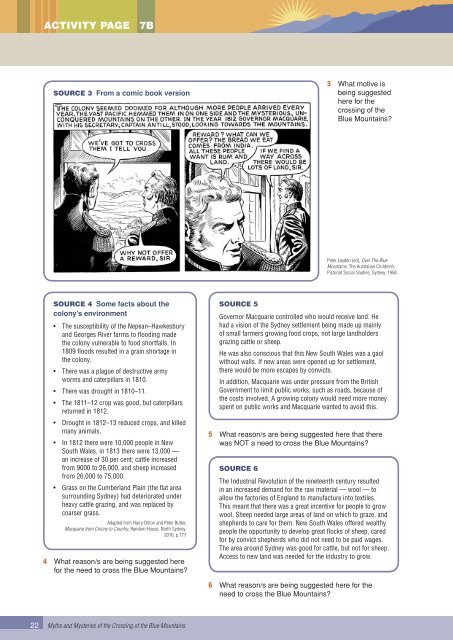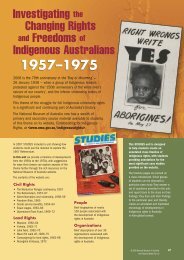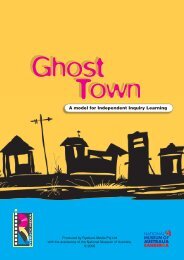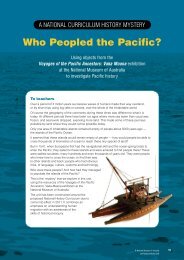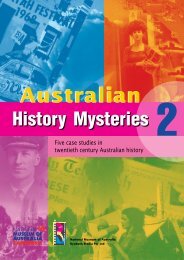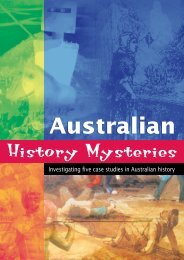Download Teacher Guide & Print Resources - Australian History ...
Download Teacher Guide & Print Resources - Australian History ...
Download Teacher Guide & Print Resources - Australian History ...
Create successful ePaper yourself
Turn your PDF publications into a flip-book with our unique Google optimized e-Paper software.
Activity page<br />
7B<br />
Source 3 From a comic book version<br />
3 What motive is<br />
being suggested<br />
here for the<br />
crossing of the<br />
Blue Mountains?<br />
Peter Leyden (ed), Over The Blue<br />
Mountains, The <strong>Australian</strong> Children’s<br />
Pictorial Social Studies, Sydney, 1958<br />
Source 4 Some facts about the<br />
colony’s environment<br />
• The susceptibility of the Nepean–Hawkesbury<br />
and Georges River farms to flooding made<br />
the colony vulnerable to food shortfalls. In<br />
1809 floods resulted in a grain shortage in<br />
the colony.<br />
• There was a plague of destructive army<br />
worms and caterpillars in 1810.<br />
• There was drought in 1810–11.<br />
• The 1811–12 crop was good, but caterpillars<br />
returned in 1812.<br />
• Drought in 1812–13 reduced crops, and killed<br />
many animals.<br />
• In 1812 there were 10,000 people in New<br />
South Wales, in 1813 there were 13,000 —<br />
an increase of 30 per cent; cattle increased<br />
from 9000 to 26,000, and sheep increased<br />
from 26,000 to 75,000.<br />
• Grass on the Cumberland Plain (the flat area<br />
surrounding Sydney) had deteriorated under<br />
heavy cattle grazing, and was replaced by<br />
coarser grass.<br />
Adapted from Harry Dillon and Peter Butler,<br />
Macquarie from Colony to Country, Random House, North Sydney,<br />
2010, p.177<br />
4 What reason/s are being suggested here<br />
for the need to cross the Blue Mountains?<br />
Source 5<br />
Governor Macquarie controlled who would receive land. He<br />
had a vision of the Sydney settlement being made up mainly<br />
of small farmers growing food crops, not large landholders<br />
grazing cattle or sheep.<br />
He was also conscious that this New South Wales was a gaol<br />
without walls. If new areas were opened up for settlement,<br />
there would be more escapes by convicts.<br />
In addition, Macquarie was under pressure from the British<br />
Government to limit public works, such as roads, because of<br />
the costs involved. A growing colony would need more money<br />
spent on public works and Macquarie wanted to avoid this.<br />
5 What reason/s are being suggested here that there<br />
was NOT a need to cross the Blue Mountains?<br />
Source 6<br />
The Industrial Revolution of the nineteenth century resulted<br />
in an increased demand for the raw material — wool — to<br />
allow the factories of England to manufacture into textiles.<br />
This meant that there was a great incentive for people to grow<br />
wool. Sheep needed large areas of land on which to graze, and<br />
shepherds to care for them. New South Wales offered wealthy<br />
people the opportunity to develop great flocks of sheep, cared<br />
for by convict shepherds who did not need to be paid wages.<br />
The area around Sydney was good for cattle, but not for sheep.<br />
Access to new land was needed for the industry to grow.<br />
6 What reason/s are being suggested here for the<br />
need to cross the Blue Mountains?<br />
22<br />
Myths and Mysteries of the Crossing of the Blue Mountains


